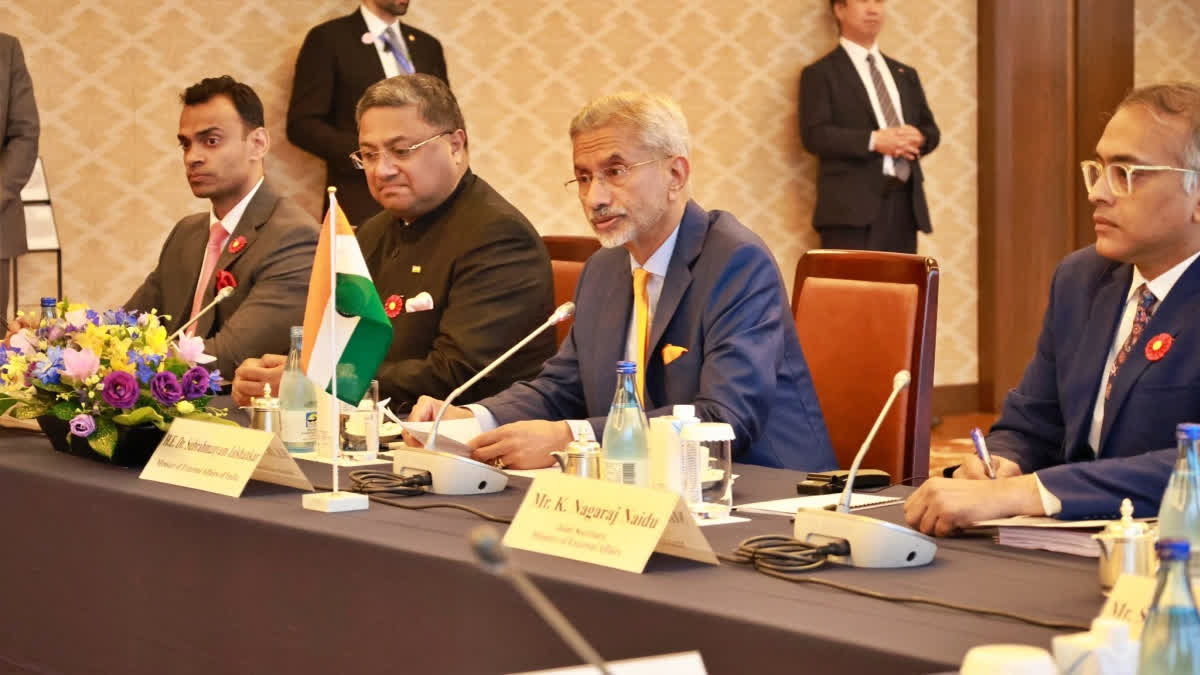New Delhi: In a stern reply, Minister for External Affairs Jaishankar on Monday said that it is for both India and China to talk and to find a way to the border issue adding "We are not looking to other countries to sort out the issue between us."
In response to a media query about growing border tension between India and China, EAM Jaishankar in Tokyo said, "We have a problem, an issue between India and China. It is for the two of us to talk it over and find a way. Other countries would have an interest in the matter because we are two big countries and the state of the relationship has an impact on the rest of the world, but we are not looking to other countries to sort out the issue between India and China. I have met China's Foreign Minister twice this month. It is an issue between the two of us and we need to settle it between us...if countries have agreements, countries should abide by the agreements."
Jaishankar was addressing the Japan National Press Club on Monday. This comes following the Quad Foreign Ministers meeting in Tokyo. In the joint statement following the Quad Foreign Ministers meeting in Tokyo, the Quad leaders in a message to China, reaffirmed their conviction that international law, including respect for sovereignty and territorial integrity and the maintenance of peace, safety, security and stability in the maritime domain underpin the development and prosperity of the Indo Pacific.
Speaking to the press in Tokyo. https://t.co/aShYL1jcuK
— Dr. S. Jaishankar (@DrSJaishankar) July 29, 2024
"We emphasise the importance of adherence to international law, particularly as reflected in the United Nations Convention on the Law of the Sea (UNCLOS), to address challenges to the global maritime rules-based order, including with respect to maritime claims, and in the South and East China Seas," the statement read
Quad Foreign Ministers meeting in Tokyo
The Quad Foreign Ministers were seriously concerned about the situation in the East and South China Seas and reiterated their strong opposition to any unilateral actions that seek to change the status quo by force or coercion.
"We continue to express our serious concern about the militarisation of disputed features, and coercive and intimidating manoeuvres in the South China Sea. We also express our serious concern about the dangerous use of Coast Guard and Maritime Militia vessels, the increasing use of various kinds of dangerous manoeuvres, and efforts to disrupt other countries’ offshore resource exploitation activities. We affirm that maritime disputes must be resolved peacefully and in accordance with international law, as reflected in UNCLOS," it added.
The Quad leaders emphasised the importance of maintaining and upholding freedom of navigation and overflight, other lawful uses of sea, and unimpeded commerce consistent with international law.
"We re-emphasise the universal and unified character of UNCLOS and reaffirm that UNCLOS sets out the legal framework within which all activities in the oceans and the seas must be carried out. We reiterate that the award rendered by the Arbitral Tribunal on July 12, 2016, is a significant milestone, and the basis for peacefully resolving disputes between the parties," the Quad Foreign Ministers said in the joint statement.
Tensions in the Galwan Valley began to escalate in early 2020
The Galwan Valley conflict between India and China, which erupted in June 2020, is a significant chapter in the broader India-China border dispute. The Galwan Valley is located in the Ladakh region of northern India, near the Line of Actual Control (LAC), which is the de facto border between India and China in this region.
Tensions in the Galwan Valley began to escalate in early 2020, following a series of confrontations and standoffs between Indian and Chinese troops. Both sides had been engaged in a prolonged buildup of troops and infrastructure along the LAC, exacerbating tensions.
On June 15, 2020, a violent clash occurred between Indian and Chinese troops in the Galwan Valley. This confrontation was one of the deadliest since the 1962 Sino-Indian War.
Both sides engaged in hand-to-hand combat, using makeshift weapons and there were no firearms involved, according to initial reports. The clash resulted in significant casualties on both sides, with India officially reporting 20 soldiers killed and China not disclosing its exact casualties, although estimates suggest a similar number.
The confrontation reportedly began after Chinese troops tried to obstruct Indian patrols. The skirmish involved violent physical altercations, and both sides accused each other of escalating the situation.
Following the clash, there was an immediate diplomatic and military response. Both nations engaged in high-level talks to de-escalate the situation. The two countries held discussions through diplomatic channels and military commanders to prevent further conflict.
Galwan Valley clash impacted India-China ties
The Galwan Valley clash significantly impacted India-China relations, leading to heightened military alertness, a reevaluation of bilateral ties, and increased calls for self-reliance in strategic sectors from India. There was also an impact on trade relations, with India imposing restrictions on Chinese apps and investments in various sectors.
Despite attempts to de-escalate, tensions remain high in the region. Both countries have continued to deploy significant military resources along the LAC, and there have been subsequent rounds of talks aimed at disengaging troops and reducing tensions.
Both India and China have been strengthening their infrastructure and military presence in the region, leading to a heightened state of alert. Both sides have also worked to maintain dialogue to manage and resolve disputes through peaceful means.
The Galwan Valley incident underscores the complexity and volatility of the India-China border dispute. While diplomatic and military dialogues are ongoing, the situation remains fluid, and the potential for future conflicts or confrontations continues to be a concern.
Read More



